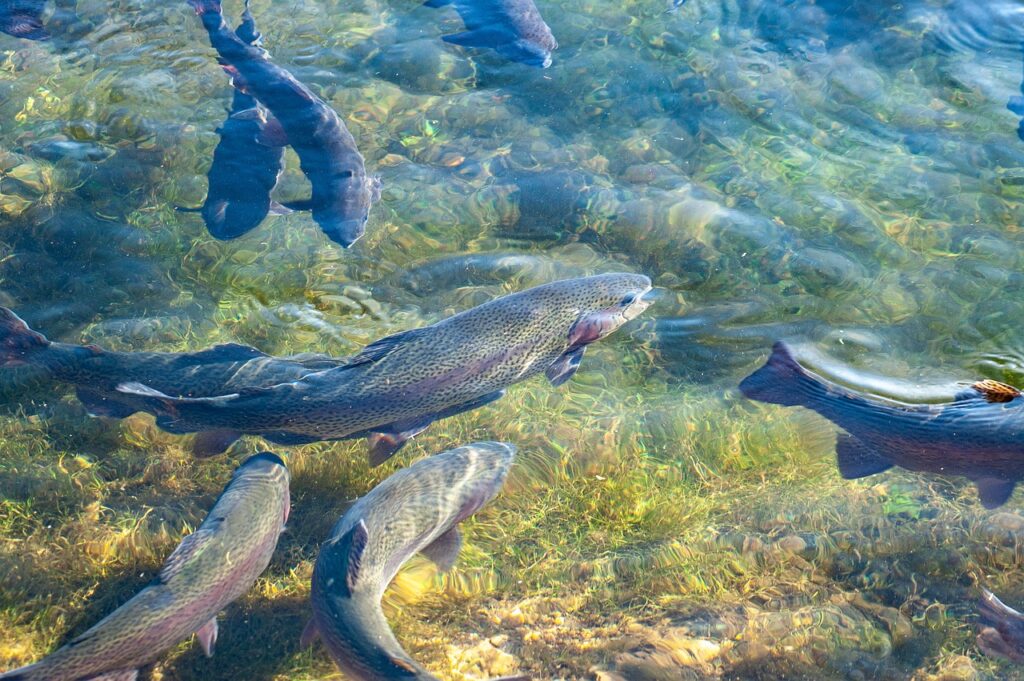Aquaponics is a sustainable and innovative way of growing plants and fish together in a closed-loop system. It combines aquaculture, the farming of fish, with hydroponics, the cultivation of plants without soil, to create a mutually beneficial ecosystem. In this blog, we will explore the basics and benefits of aquaponics, the types of fish that work best, and the equipment needed to set up an aquaponic system.
Basics of Aquaponics
Aquaponics works by using the waste produced by fish as a source of nutrients for plants, while the plants purify the water in which the fish live. In this way, the system creates a symbiotic relationship between the fish and plants, resulting in a sustainable and eco-friendly way of growing both.
The system consists of three main components: the fish tank, the grow bed, and the water pump. The fish tank holds the fish, which produce waste in the form of ammonia. This waste is pumped into the grow bed, where it is converted into nitrites and then nitrates by beneficial bacteria. The nitrates act as a natural fertilizer for the plants, which absorb them through their roots, purifying the water in the process. The cleaned water is then returned to the fish tank, completing the cycle.
Benefits of Aquaponics
Aquaponics offers a range of benefits, both for the environment and for the grower. Here are some of the main advantages of using an aquaponic system:
Sustainable: Aquaponics is an eco-friendly way of growing plants and fish, as it recirculates the water and nutrients in a closed-loop system. It uses less water than traditional farming and eliminates the need for chemical fertilizers.
High Yield: Aquaponics can produce a high yield of both fish and plants, as the nutrient-rich water allows for faster growth and higher yields.
Space Efficient: Aquaponics systems can be set up in small spaces, making it an ideal option for urban or indoor farming.
Easy to Maintain: Once set up, aquaponic systems require little maintenance, as the plants and fish take care of each other’s needs.
Fresh and Organic Produce: Aquaponic systems allow growers to produce fresh and organic produce all year round, without the need for pesticides or herbicides.
Types of Fish
When it comes to choosing the fish for your aquaponic system, it is important to consider a few key factors. The fish should be able to tolerate the water temperature and pH levels of the system, as well as have a diet that produces the right amount of waste for the plants to thrive. Here are some of the most common fish used in aquaponics:
Tilapia: Tilapia is a hardy fish that can tolerate a wide range of water conditions. It is also a fast-growing fish and produces a high amount of waste, making it a popular choice for aquaponics.
Trout: Trout is a cold-water fish that requires lower water temperatures than tilapia. It is also a fast-growing fish and produces a high amount of waste.
Catfish: Catfish is a bottom-dwelling fish that can tolerate a wide range of water conditions. It is also a good source of protein and produces a high amount of waste.
Koi: Koi are ornamental fish that are popular in aquaponics due to their bright colors and hardy nature. They produce a moderate amount of waste and can tolerate a range of water conditions.
Equipment Needed
To set up an aquaponic system, you will need the following equipment:
Fish Tank: The fish tank is where the fish will live and produce waste. It should be large enough to hold the number of fish you plan to keep and should have a cover to prevent the fish from jumping out.
Grow Bed: The grow bed is where the plants will be grown. It should be large enough to hold the number of plants you plan to grow and should be filled with a growing medium, such as expanded clay pellets or coconut coir.
Water Pump: The water pump is used to circulate the water between the fish tank and grow bed. It should be sized to match the volume of water in your system.
Aeration System: An aeration system is used to oxygenate the water in the fish tank, which is necessary for the health of the fish.
Beneficial Bacteria: Beneficial bacteria are used to convert the fish waste into a form that the plants can use. They can be purchased as a liquid or powder and should be added to the system regularly.
Fish Feed: The fish in your system will need to be fed a high-quality fish feed to ensure they are healthy and produce enough waste for the plants.
Testing Kits: Testing kits are used to monitor the pH and nutrient levels in your system. It is important to keep these levels within a specific range to ensure the health of your fish and plants.
In conclusion, aquaponics is a sustainable and innovative way of growing plants and fish together in a closed-loop system. It offers a range of benefits, including sustainability, high yields, space efficiency, and fresh and organic produce. When choosing the fish for your aquaponic system, it is important to consider factors such as water temperature and pH levels, as well as the fish’s diet. To set up an aquaponic system, you will need a fish tank, grow bed, water pump, aeration system, beneficial bacteria, fish feed, and testing kits. With the right equipment and knowledge, anyone can set up an aquaponic system and enjoy the benefits of sustainable and eco-friendly farming.

